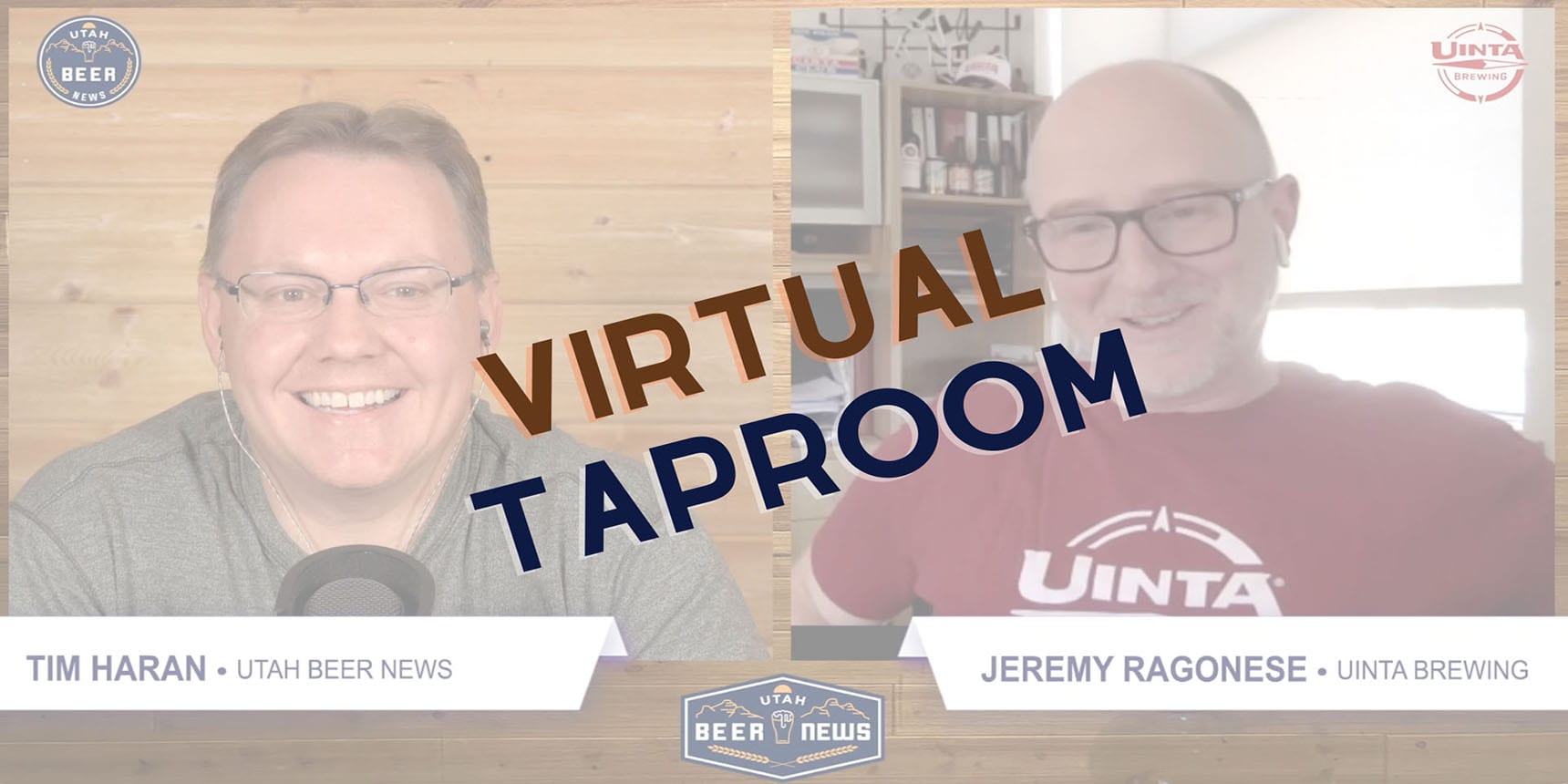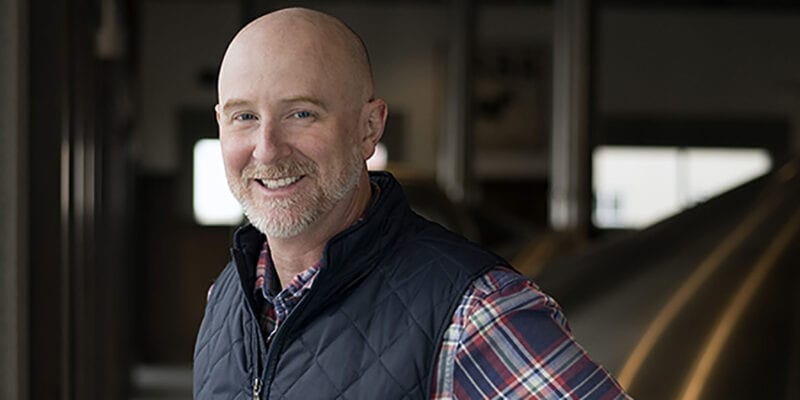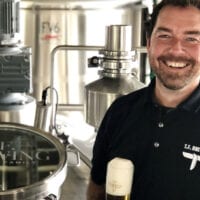
Uinta Brewing joins Utah Beer News for the latest episode of our Virtual Taproom video series.
President Jeremy Ragonese visits with Tim Haran to discuss a variety of topics, including:
- His start in craft beer. And his path to becoming president at Uinta Brewing
- The vision of Uinta, which began brewing in Utah in 1993
- The importance of American Craft Beer Week and supporting local, independent craft breweries
- What Uinta Brewing has planned for American Craft Beer Week
- And more!
About the Utah Beer News Virtual Taproom
Utah Beer News conducts 15-minute video interviews with brewers, breweries, and everyday imbibers. We record these brief conversations virtually. They are uploaded the same day (or the next day) to the Utah Beer News YouTube channel.
Instead of the more in-depth interviews and brewery histories typical of the Utah Beer News Podcast episodes and Brewery Profile articles, these bite-sized conversations feature so-called “newsy” information. We talk about new beer releases, upcoming events, and general happenings in and around Utah’s craft breweries.
If you’re a brewer or brewery representative — or even an everyday imbiber with a story to share — and would like to participate in an upcoming episode, please fill out the contact form.

Uinta Brewing Transcript
The following is a slightly edited transcript of our conversation. And here’s a previous article we wrote about Uinta Brewing.
[Tim Haran]
Hi again, everyone. Thank you for joining Utah Beer News for the latest in our one-on-one conversations with local brewers, breweries, and everyday imbibers. I’m Tim Haran, founder of Utah Beer News. And my guest today is Jeremy Ragonese, president of Uinta Brewing in Salt Lake City.
Welcome, Jeremy.
[Jeremy Ragonese]
Hi, Tim. How are you? It’s great to see you again.
[Tim Haran]
I’m doing great. It’s good to see you as well. Thanks for taking the time to talk with Utah Beer News. Jeremy has been kind enough to join us to talk about what is new and exciting with Uinta Brewing. And as someone with a distinguished career in craft beer, he’s going to share some thoughts on the importance of American Craft Beer Week, which is set for May 10-16.
Alright, Jeremy. Let’s spend just a couple minutes talking about you and Uinta Brewing. You’ve seen a thing or two in craft beer throughout your career. Can you start by talking a little about how you got into the industry? And the path that led you to become president at Uinta Brewing in 2019?
[Jeremy Ragonese]
Sure. Absolutely. Thank you. My journey into craft beer started through kind of an odd angle. I was a partner in an advertising firm in Kansas City, Mo. I was young, in my early-20s, I think, or mid-20s, somewhere around there. I’d started a shop with some friends. And in walks the vice president of sales and marketing for Boulevard Brewing Company saying they needed a radio ad.
With that we became their first agency for Boulevard Brewing Company, first official agency. Started with a very simple one project turned into multi-years of doing point-of-sale and print ads and all kinds of stuff for them. Working with their in-house creative department of one to be able to help assist them in their growth. At one point in time we had sold the agency. I was having breakfast with the VP of sales and marketing and they said they were going to hire a director of marketing. He didn’t even ask, I just said, when do I apply.
So it was kind of a situation where I knew the brand pretty intimately at that point and had established good relationships with everyone there and just knew that it was such a unique time in the industry and that brewery in particular was a champion of the Midwest and represented the best of Kansas City, so to be on that team was exciting and new.
They had just built an entire new facility to be able to start expansion nationally. At that moment in time they had a total of eight beers they produced — four year-rounds and four seasonals. I seriously thought at that time that was enough. That was going to be the end. We were way deep in it. I was just going to continue to grow that brand and about a year later we started a trajectory of launching new beers about every 10 minutes, I think.
But it was great to see and great to experience that from the inside. At that time the industry was in its high growth phase. Being in the Midwest we were a little insulated from that.
I had a chance to kind of get a wider view of what the industry was going through. Stayed there for about 10 years and then through a merger with Duvel Moortgat, or an acquisition, I should say, with Duvel Moortgat, they acquired Firestone in that time period as well and we had to put together a national salesforce and do a bunch of things that were very stressful but also very rewarding.
But I just found myself at the end of those 10 years thinking maybe it was time to either go back into advertising or find something new to keep myself moving forward. I got a phone call from a buddy of mine who had moved to Salt Lake to run Uinta, who I had worked with before and he asked if I would mind coming out and maybe helping out for a little while here on the marketing side.
They had a great team here already, so for me it was kind of a plug in and see what I can do to assist. But, honestly, after that I fell in love with Salt Lake and sort of the rest is history.
We’ve had some changes in the management team here and I was approached about joining as president after the gentleman who had brought me here had left to go work for Maine Brewing Company. And I said, sure. Let’s see how this goes. I was excited.
[Tim Haran]
Very cool.
[Jeremy Ragonese]
That was probably way more than you expected.
[Tim Haran]
No, no, that’s great. The marketing background and the ad agency background. That’s great to hear. Like you said, you’d been at Uinta, how many years now total at Uinta?
[Jeremy Ragonese]
Five years now.
[Tim Haran]
Five years. And going on three as president.
Uinta Brewing started in 1993. Perhaps much more than any other brewery, Uinta is rooted in Utah. What is the mission statement or maybe overarching big-picture objective for Uinta in your mind?
[Jeremy Ragonese]
Uinta has always stood for the state of Utah, meaning our brand resonates with the residents of Utah but we also export the idea of Utah and what we stand for here.
We’re a lifestyle brand, very much tied in with the landscapes and the people and the wonderful aspects that represent Utah as a western state, Intermountain West state. The things that have resonated with me for a long, long time specifically is that we’re a very sustainably minded brewery with Earth, Wind, and Beer being a tagline for a long time because of the first business in the state of Utah to sign up for the wind power program that Rocky Mountain Power offered.
I think a mindful company for the environment, a company that represents local, which local again can be defined as in state, in my opinion, and then from that standpoint a good steward of the community and a business that represents what we do very, very well.
So that’s a longwinded vision statement but our goal ultimately is to be the No. 1 craft brewery in the state of Utah from both a quality standpoint and recognition standpoint, those kinds of things. Because honestly, that’s the heart and soul of what we do and why we do it.
[Tim Haran]
Obviously, some of Uinta’s classic beers — Cutthroat Pale Ale, Hop Nosh IPA, 801 Pilsner, so many — all beers that likely were among some of the first craft beers that helped to get people hooked on craft beer.
How has the brand evolved over the years? And how do you go about balancing the classics with a steady stream of new beers you’re putting into the market?
[Jeremy Ragonese]
That’s kind of a classic challenge for breweries that are considered to be the old guard of craft beer. I guess the legacy of our business is that we’ve made beers that are widely available and people kind of miss the fact that they’re widely available for a reason.
They were popular beers to begin with and ultimately they’re very consistent beers in the market and we do a good job with our sales and marketing and distribution plan. That’s not a failure, that’s a success story.
When you see our beers on shelves and again, they’re still selling very, very well. That’s a good thing. The issue is you always want to approach the new consumer, the coming-of-age consumer in a way that makes you approachable and relevant in a way to that audience.
Relevance to us means hard seltzer today. We launched Westwater Hard Seltzer last year and that market is growing fast and to put a stake in the ground even as late as we did relative to what was going on nationally is still very, very important. Because, again, those occasions when people are reaching for a beer or other products, they have a lot of options out there.
I would prefer them to choose local options, something that supports jobs locally, something that really helps us sustain our business and luckily we made a very good hard seltzer, so consumers adopted it quite quickly.
Beyond that, Was Angeles is a new brand for us. It’s a lager, it’s very straightforward from a beer standpoint, but the idea behind it was again to embrace the local community and share something we all share in common, which is a little bit of that frustration when you go up in the canyons and you’re stuck behind taillights all day.
For us, that’s a nod to our community and a nod to the people that drive our business forward. And the beer is excellent, too, so that’s the piece that it’s not just a brand. It is actually a very, very good, very crushable craft beer.
So relevancy is to where you are, meaning the consumer, and to where the audience wants us to be. I’m still drinking double IPAs all day long, so I don’t know about what the rest of the world is leaning towards the lighter end of the category right now.
I’ve got a Caravan in my fridge that’s waiting for me when I get home today.
[Tim Haran]
That was my next comment. I have a note here. Two of your newer beers are just phenomenal. Caravan, like you mentioned, and then Sonder, double dry-hopped double IPA. I just can’t get enough of that. Those are two of my current favorites.
[Jeremy Ragonese]
Thank you.
[Tim Haran]
OK. May 10-16 is American Craft Beer Week. This is the 15th annual event that really celebrates local, independent craft beer. You touched on that a little bit with making sure that if you’re going to choose something, try and make it local.
The past 14+ months have been so challenging, to say the least, for small businesses. And craft breweries are in that group. Can you talk a little bit about the importance of supporting local when it comes to craft beer? Not just next week but all year-round?
[Jeremy Ragonese]
Oh, very happy to. Thank you. Craft Beer Week, when it started for the Brewers Association, and I remember back that far, when it did start, it was designed to be a PR campaign to really promote craft beers as an industry when we were still less than probably 1,000 breweries or 1,400 breweries across the country. The idea there was to shine a light on the industry and to get people to visit their local craft brewery.
And at the time, the distance to your local craft brewery may have been 30 miles. Now, it’s probably less than five or 10 with the 8,000 breweries in the country. Again, the motivation is the same. I think the Brewers Association would encourage everyone to visit their local breweries, visit the taprooms just to understand that their presence and community tends to raise the community up.
It’s a gathering spot, it’s a place where people can hang out and touch and feel something that’s made locally. Meet the people who are behind that. It’s the age-old story of revitalization of places where perhaps things have been left behind in the past and breweries come in and build an infrastructure and welcome people back to those neighborhoods.
It’s such an important story and from my standpoint, American Craft Beer Week in a broader sense, you know, was about when you’re out in the market, make a conscious decision to pick a craft beer that you haven’t tried before. And try a new brewery. I’m not ashamed to admit, I drank a SaltFire beer last night I’ve never had before. The name Big in Japan for SaltFire, you know, I was intrigued immediately.
That idea, for me, is the same. I want to try what’s out there, too. And I want to support the local craft brewers that I’m friends with and that I know are struggling to make their ends meet.
For right now, especially, many of these brewers had to maintain their businesses under extreme duress and really had not a lot of fall-back position. I have packaging beer and packaging beer was what was selling last year and I had areas that I could continue to move it. It still hurt. I still had to revise my business plan in a very hard way, in a very short amount of time.
I can’t imagine what people that relied on their taproom business, you know I talked to our friends at Fisher and others and they had to make so many tough decisions. It’s heartbreaking when you spend all of your energy in a passion business and you see it go through that extreme amount of pressure.
From my standpoint, go out and support local because, frankly, those are the people that are going to support you in whatever your endeavor is.
[Tim Haran]
It’s been so neat to see the resilience of the brewers and the community, too, supporting the breweries during this time. It’s been really cool to see.
Generally, during American Craft Beer Week, breweries will offer special beer releases, coordinate taproom activities. Last year was obviously a scaled-back version of a typical American Craft Beer Week.
What’s your impression of this year’s festivities? Are we going to be back to normal, do you think?
[Jeremy Ragonese]
As back close to normal as we can get. Utah luckily did have a period, I shouldn’t say luckily, we had a period when the situation with the pandemic got very, very bad and luckily we’re now spending way more time outside.
Of course the vaccination rates are going up and we in Salt Lake are looking pretty good, I think. So overall, welcoming people back inside the taproom or patio area, things like that, it’s happening. And I think most people are starting to feel comfortable with that. I know I am, which is good. I do have my first shot, so I feel invincible all of a sudden and I see a lot of people thinking the same thing. That’s key.
We’re welcoming people back with some special releases. We’ve actually got on Monday two beers that we’re tapping that were part of our R&D program that were special dry-hopped.
We’ve got a Was Angeles that’s dry-hopped with the Pink Boots Society hop blend from this year. And then we’ve got a Golden Spike that is dry-hopped with an experimental hop to give it the hop itself has got characteristics of strawberry, tropical fruit and things, so it gives Golden Spike a really nice hoppy wheat edge.
And then on Wednesday, I believe, we’ve got another special release that’s coming out with Trader with the New Zealand variety Motueka that was used in our Tu Meke Tart. It has a lot of real lime juice, key lime character to it.
Those are three dry-hopped varietals that we’ll have special. And then there are specials going on with our retail store and merch and things like that.
So the week itself will have some festive feelings here. I think they’re actually running some promotions in the pub. You can win some prizes too and things. There’s a flight of beers. If you can guess what the beers are you win a prize, stuff like that. It should be fun.
[Tim Haran]
How are you going to celebrate? What are your plans?
[Jeremy Ragonese]
I’m probably going to celebrate the way that I celebrate every week. I’m going to have some Uinta beers at the end of the day.
The goal for me is to thank everyone for coming into the pub and just really make sure that I’m available to welcome folks in and say that we appreciate their business because that’s the most important thing I can do.
I also will encourage anybody that I do see to take a tour of some of the other breweries while they’re here. We get a lot of folks coming in from the airport that stop by here.
We’re kind of the first brewery in or the last brewery before they head out. It’s always good to, again, be a good advocate or ambassador for Utah.
[Tim Haran]
That’s a good point as we wrap up here, aside from American Craft Beer Week, what should beer drinkers be keeping an eye out for when it comes to Uinta Brewing in the next little while.
You’ve got that new spot at the airport. How’s that going for you?
[Jeremy Ragonese]
It’s been going great, but for those guys, very stressful too. It’s a situation where the airport itself, traffic was down relative to what it would have been. All the COVID protocols meant they had to change those routines. It’s a difficult business to begin with. We’re actually not the operators of that location. We have a partner that operates that.
Again, very, very stressful and they’re very experienced in restaurant operations in airports but it’s just a totally different world for them. They’re learning to navigate those things and hopefully with tourism back on the rise and flights coming in and everything it will hit the normal button soon.
From our perspective, we’re actually going to start hosting events again. We put that on hiatus last year. There will be some free events in our parking lot. We’ve partnered with Kuul, the outdoor clothing brand. They’re partners of ours already but they’re also neighbors and good friends.
They’re going to bring their Kuul Mule that is a big truck that has a stage attached, or part of it, I should say, not attached. It is a truck with a stage. Bring that out, we’ll have some live music in our parking lot and Nomad, our partner on the eatery here for the pub, will be cooking up some fresh, different food varieties, of course beer will be flowing.
These are coming up on Saturdays. I’ve got to look at my, oh May 21. I was going to say the wrong date but May 21 is when those are going to kick off, so if you watch our social feed you’ll learn about that.
Other than that, I’ve got to say happy third anniversary, Tim. That’s a really wonderful achievement. You’re part of the community here in a big, big way because you help us share this kind of message.
Also, you really show great support for all the breweries here and I can’t tell you how much we all appreciate it.
[Tim Haran]
Well, thank you very much. I appreciate you saying that. It’s been a fun ride so far. I’m excited. This little video series is something that we just started not too long ago. So you’re an early adopter to this one. I appreciate you taking the time to visit with us for American Craft Beer Week.
[Jeremy Ragonese]
I loved it. I’m happy to talk about my favorite subject any time, so I appreciate it, Tim.



